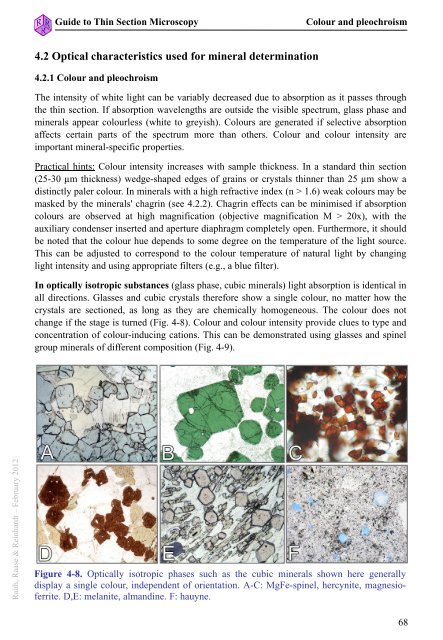guide to thin section microscopy - Mineralogical Society of America
guide to thin section microscopy - Mineralogical Society of America
guide to thin section microscopy - Mineralogical Society of America
Create successful ePaper yourself
Turn your PDF publications into a flip-book with our unique Google optimized e-Paper software.
Guide <strong>to</strong> Thin Section Microscopy<br />
Colour and pleochroism<br />
4.2 Optical characteristics used for mineral determination<br />
4.2.1 Colour and pleochroism<br />
The intensity <strong>of</strong> white light can be variably decreased due <strong>to</strong> absorption as it passes through<br />
the <strong>thin</strong> <strong>section</strong>. If absorption wavelengths are outside the visible spectrum, glass phase and<br />
minerals appear colourless (white <strong>to</strong> greyish). Colours are generated if selective absorption<br />
affects certain parts <strong>of</strong> the spectrum more than others. Colour and colour intensity are<br />
important mineral-specific properties.<br />
Practical hints: Colour intensity increases with sample thickness. In a standard <strong>thin</strong> <strong>section</strong><br />
(25-30 μm thickness) wedge-shaped edges <strong>of</strong> grains or crystals <strong>thin</strong>ner than 25 μm show a<br />
distinctly paler colour. In minerals with a high refractive index (n > 1.6) weak colours may be<br />
masked by the minerals' chagrin (see 4.2.2). Chagrin effects can be minimised if absorption<br />
colours are observed at high magnification (objective magnification M > 20x), with the<br />
auxiliary condenser inserted and aperture diaphragm completely open. Furthermore, it should<br />
be noted that the colour hue depends <strong>to</strong> some degree on the temperature <strong>of</strong> the light source.<br />
This can be adjusted <strong>to</strong> correspond <strong>to</strong> the colour temperature <strong>of</strong> natural light by changing<br />
light intensity and using appropriate filters (e.g., a blue filter).<br />
In optically isotropic substances (glass phase, cubic minerals) light absorption is identical in<br />
all directions. Glasses and cubic crystals therefore show a single colour, no matter how the<br />
crystals are <strong>section</strong>ed, as long as they are chemically homogeneous. The colour does not<br />
change if the stage is turned (Fig. 4-8). Colour and colour intensity provide clues <strong>to</strong> type and<br />
concentration <strong>of</strong> colour-inducing cations. This can be demonstrated using glasses and spinel<br />
group minerals <strong>of</strong> different composition (Fig. 4-9).<br />
Raith, Raase & Reinhardt – February 2012<br />
Figure 4-8. Optically isotropic phases such as the cubic minerals shown here generally<br />
display a single colour, independent <strong>of</strong> orientation. A-C: MgFe-spinel, hercynite, magnesi<strong>of</strong>errite.<br />
D,E: melanite, almandine. F: hauyne.<br />
68
















